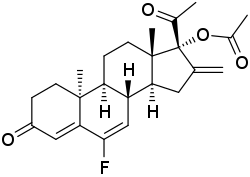DU-41165
DU-41165, also known as 6-fluoro-16-methylene-17α-acetoxy-δ6-retroprogesterone, is a progestin which was developed by Philips-Duphar in the 1970s and was never marketed.[1][2] It is a combined derivative of 17α-hydroxyprogesterone and retroprogesterone.[1][2] The drug shows extremely high potency as a progestogen in animals.[1] It has been found to possess 158% of the relative binding affinity of promegestone for the progesterone receptor expressed in rat uterus (relative to 74% for the closely related progestin DU-41164).[1] DU-41165 also showed 28% of the affinity of RU-28362 for the glucocorticoid receptor expressed in rat liver, but no affinity for the mineralocorticoid receptor expressed in rat kidney (<0.003% of that of RU-26752).[1] The drug showed no androgenic, anabolic, or estrogenic activity in animals, but did show some antiandrogenic and glucocorticoid activity at high doses.[1] Although highly potent in animals, DU-41165 produced little or no progestogenic effect at dosages of 50 and 200 µg/day in women, suggesting major species differences.[1] DU-41165 has been studied as a potential photoaffinity label for the progesterone receptor.[1]
 | |
| Clinical data | |
|---|---|
| Other names | 6-Fluoro-16-methylene-17α-acetoxy-δ6-retroprogesterone; 6-Fluoro-16-methylene-17α-hydroxy-9β,10α-pregna-4,6-diene-3,20-dione 17α-acetate; 6-Fluoro-16-methylene-3,20-dioxo-9β,10α-pregna-4,6-dien-17α-yl acetate |
| Routes of administration | By mouth |
| Drug class | Progestin; Progestogen |
| Identifiers | |
IUPAC name
| |
| CAS Number | |
| PubChem CID | |
| ChemSpider | |
| Chemical and physical data | |
| Formula | C24H29FO4 |
| Molar mass | 400.49 g/mol g·mol−1 |
| 3D model (JSmol) | |
SMILES
| |
InChI
| |
References
- Morsink L, de Wachter AM, Brenner P, Cekan SZ, Guerrero R, Hagenfeldt K, Diczfalusy E (May 1976). "Endocrine effects of two new retro-steroids in animal models and in women". Acta Endocrinol. 82 (1): 193–212. doi:10.1530/acta.0.0820193. PMID 57688.
- Pinney KG, Carlson KE, Katzenellenbogen JA (February 1990). "[3H]DU41165: a high affinity ligand and novel photoaffinity labeling reagent for the progesterone receptor". J. Steroid Biochem. 35 (2): 179–89. doi:10.1016/0022-4731(90)90272-T. PMID 2308335.
Glucocorticoid receptor modulators | |||||||||
|---|---|---|---|---|---|---|---|---|---|
| GR |
| ||||||||
| |||||||||
Progesterone receptor modulators | |||||||
|---|---|---|---|---|---|---|---|
| PR |
| ||||||
| mPR (PAQR) |
| ||||||
| |||||||